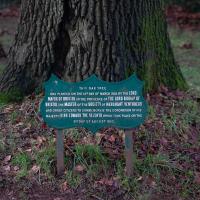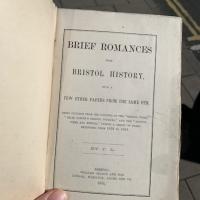Tagged: lond
My historical research took a wander underground recently, partly inspired by the Canynge Square sinkhole, partly by St Vincent's (Ghyston's) cave and its tunnel to the Observatory, and I was surprised to find that there might be an intact tunnel from the Bristol Port Railway and Pier still just sitting there under Bridge Valley Road. A quick search turned up this recent video by an intrepid explorer, so it's definitely still there.
I went looking for the entrances today, and definitely found the south entrance, at the start of the Bridge Valley Path, the footpath that starts with steps at the bottom of Bridge Valley Road. It's easy to miss if you're not looking for it. I think I've figured out where the north entrance is, too, but it was getting dark at that stage and the Portway was still busy enough that crossing the road was still the normal nuisance, so I thought I'd leave further explorations for another day.
- Nice. It's just on the other side of the Promenade from the Alderman Proctor's Drinking Fountain.
Tags: Bristol Places UK onemilematt united kingdom Clifton Society of Merchant Venturers
Auto-Tags: Natural landscape Plant Wood Terrestrial plant Trunk Grass Twig Biome Woody plant Tree Deciduous Groundcover Font Forest Landscape
Text Recognition Tags: THIS OAK TREE MAS PLANTED UN THE 14 DAY OF MARCH 903 BY THE LOKD MAYOR OF BRISTOL IN THE PRESENCE OF THE LOND BISHUP OF BRISTOLTHE MASTER OF THE SOCIETY or MERCHANT VENTURERS AND OTHER CITIZENS TO COMMLMORAIE THE CORONATION OF HIS NAJESTY EDWARD THE SEVENTH.WHICH TOOK PLACE ON THE DDAY OF AUGUST 1902. THIS OAK TREE MAS PLANTED UN THE 14 DAY OF MARCH 903 BY THE LOKD MAYOR OF BRISTOL IN THE PRESENCE OF THE LOND BISHUP OF BRISTOLTHE MASTER OF THE SOCIETY or MERCHANT VENTURERS AND OTHER CITIZENS TO COMMLMORAIE THE CORONATION OF HIS NAJESTY EDWARD THE SEVENTH.WHICH TOOK PLACE ON THE DDAY OF AUGUST 1902.
Shiny New Hope
24 Sep 2021
A quick lunchtime jaunt to Clifton Village. Along the way I admired the new sign on Hope Chapel and added to my tsundoku collection.
Apologies for the poor picture quality; it was a quick snap from the iPhone. There's a better picture on t'blog. It's notable that this book was written by "J L", Joseph Leech, former Bristol newspaper magnate and the man who had Burwalls Mansion built, just the other side of the Suspension Bridge.
Tags: Bristol Places UK onemilematt united kingdom Clifton Village Clifton Princess Victoria Street Joseph Leech
Auto-Tags: Wood Book Publication Font Paper Paper product Event Document Stationery
Text Recognition Tags: BRIEF ROMANCES BRISTOL HISTORY, wI A FEW OTHER PAPERS FRON THE SAME PEN. ING e r couness OF THE t "vELis FAREY's a A AND TIM AND MI sea S & E or TRA BY J. L WILLIAM GDono AND soN. LOND MAMILION ADAMEN AND C BRIEF ROMANCES BRISTOL HISTORY, wI A FEW OTHER PAPERS FRON THE SAME PEN. ING e r couness OF THE t "vELis FAREY's a A AND TIM AND MI sea S & E or TRA BY J. L WILLIAM GDono AND soN. LOND MAMILION ADAMEN AND C
I've been pretty awful at reading so far this year, apparently averaging about one book per month. That's a far cry from 2019, say, where I got through 41 books in the year. Today's wander was prompted by my rubbish reading, as I needed to go hand back some books to the library, because I'd managed to renew them so many times that I hit the limit on renewals. Oops. Several of them were still unread.
So, off to the Central Library for me, tail between my legs. On the way there I did my best to recreate a historical photo of Dowry Square; while I was in the area I walked under the adjacent Norman arch and poked around behind the Cathedral, and I also had a little diversion to the city centre and came back along the south side of the river, hitting some trouble with the lock gates as I finally crossed the harbour back towards home.
A bit more detail if you fancy it.
Tags: Bristol Places UK onemilematt united kingdom City Centre Saint Nicholas Market St Nicholas Market St. Nicholas Market Corn Street old city
Auto-Tags: Wood Font Wall Landmark Commemorative plaque Tree History Signage Memorial Metal Public utility Interior design Kitchen utensil Idiophone
Text Recognition Tags: THE CORN EXCHANGE CLOCK The clock on this building with an extra minute hand recalls early Victorian days, when Bristol was in two minds about the correct time. Although today we take Greenwich Mean Time or British Summertime for granted before 1880 no standard time existed in the British Isles. Every city had its own local time, reckoned by the sun and signed by church bells. Bristol lies 2 degrees, 36 minutes west of the Greenwich Meridian and so the sun reaches its noon nearly peak 11 minutes later than in Greenwich. Before the growth of railways, most people expected to spend their lives close to home. Travel by stagecoach or ship was slow and uncomfortable. Timetables were vague. For Bristolians a change came in June 1841, when the first through train from London pulled into Temple Meads Station. Brunel's Great Western Railway began to tempt people to travel, now they could go to London in hours rather than days. The Railways ran on London time (Greenwich Mean Time). If you wanted to catch a train at noon from Temple Meads you had to remember that it would pull out at 11:49 Bristol Time. To help Bristolians catch their trains, Bristol Corporation arranged for the main public clock on the Corn Exchange to show both local and Greenwich Mean Time (Railway Time) with two minute hands. Other clocks in Bristol adopted the same compromise, In September 1852 Bristol adopted GMT and Bristol time became the same as Lond THE CORN EXCHANGE CLOCK The clock on this building with an extra minute hand recalls early Victorian days , when Bristol was in two minds about the correct time . Although today we take Greenwich Mean Time or British Summertime for granted before 1880 no standard time existed in the British Isles . Every city had its own local time , reckoned by the sun and signed by church bells . Bristol lies 2 degrees , 36 minutes west of the Greenwich Meridian and so the sun reaches its noon nearly peak 11 minutes later than in Greenwich . Before the growth of railways , most people expected to spend their lives close to home . Travel by stagecoach or ship was slow and uncomfortable . Timetables were vague . For Bristolians a change came in June 1841 , when the first through train from London pulled into Temple Meads Station . Brunel's Great Western Railway began to tempt people to travel , now they could go to London in hours rather than days . The Railways ran on London time ( Greenwich Mean Time ) . If you wanted to catch a train at noon from Temple Meads you had to remember that it would pull out at 11:49 Bristol Time . To help Bristolians catch their trains , Bristol Corporation arranged for the main public clock on the Corn Exchange to show both local and Greenwich Mean Time ( Railway Time ) with two minute hands . Other clocks in Bristol adopted the same compromise , In September 1852 Bristol adopted GMT and Bristol time became the same as Lond


